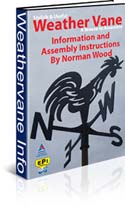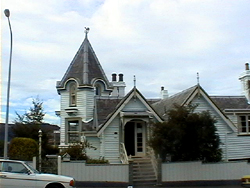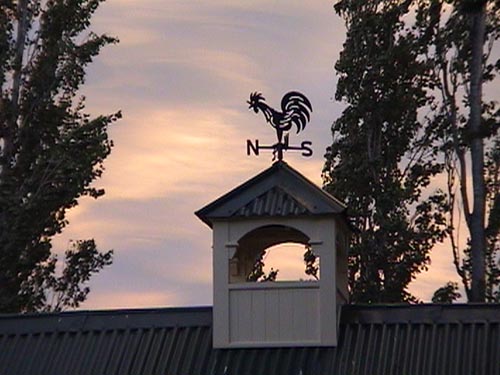Weathervane Information Page
This page contains information, videos and photographs about our weathervane. It also tells you where you can purchase them from. A a diagram about how to assemble the weathervane. If you are a retailer such as a garden centre, DIY store etc and would like to purchase this product to sell to your customers please email us. EPI Plastics does not sell direct to the public.
Norman Wood, the Managing Director of EPI Plastics puts one of his Weathervanes on top of his home.
If you click on the ebook to the left you can download our latest information about the weathervane, how it works, and how to assemble it.
Introduction by Norman, the owner of EPI which manufactures the Weathervane.
Norman explains how to put the Weathervane together.
Where Can I buy the Weathervane?
EPI Plastics is a manufacture and doesn't sell directly to the public. However, you should be able to buy it from any good garden centre, Hammer Hardware, Mitre 10, Palmers Garden Centres,and other similar stores. If they don't have one ask them to contact us and we'll send it to them for you. Our contact details are at the bottom of this page and you can pass these on to them.
What is a Weathervane and how does work?
A weather vane is an instrument for showing the direction of the wind. They are typically used as an architectural ornament to the highest point of a building. Although partly functional, weathervanes are generally decorative, often featuring the traditional cockerel design with letters indicating the points of the compass. The word 'vane' comes from the Anglo-Saxon word 'fane' meaning 'flag'.
The design of a wind vane is such that the weight is evenly distributed each side of the surface, but the surface area is unequally divided, so that the pointer can move freely on its axis. The side with the larger area is blown away from the wind direction. The pointer is therefore always on the smaller side (a north wind is one that blows from the north). Most wind vanes have directional markers beneath the arrow, aligned with the geographic directions. Wind vanes, especially those with fanciful shapes, do not always show the real direction of a very gentle wind. This is because the figures do not achieve the necessary design balance: an unequal surface area but balanced in weight. To obtain an accurate reading, the wind vane must be located well above the ground and away from buildings, trees, and other objects which interfere with the true wind direction. Changing wind direction can be meaningful when coordinated with other apparent sky conditions, enabling the user to make simple short range forecasts.
Source Wikipedia.org
Other Peoples Weathervane Photos (send your pictures to Norman Wood) -
Assembly Information
Assembly is relatively easy. See the video above. However, firstly open the box get the N-S and place it on top of the W-E. Then the Rooster is paced on top of the "spindle" or "axle" on which it spins pointing into the wind. There are a number of methods of attaching the weathervane to a house, fence etc. The assembled weathervane can sit on the top of a dowel (like a broom handle), it will need to be screwed into position so that the whole weathervane doesn't rotate, it must be fixed and only the Rooster should move. There is a small indentation in the base which is where the screw needs to be placed - you may need to drill a hole out.
The broom handle (cut down to size) or dowel then can be fixed to the side of a house or fence. Alternatively, a small block of wood could have a socket drilled out, using a "lock hole drilling attachment" to a drill. The hole into which the dowel is placed should not go all the way through the wooden block as preferably two screws needs to come up from the bottom to hold the dowel in place, alternatively it could be glued into place with "no more nails". The block is then screwed to the top of the house or turret... MAKE SURE THAT THE "N" FOR NORTH IS ACTUALLY POINTING TO THE NORTH.


Copyright Passion Plastics EPI Limited. Managing Director: Norman Wood Street Address: 225 Kaikorai Valley Road, Dunedin. Postal Address: PO Box 310, Dunedin, New Zealand
Freephone 0800 448 548 (New Zealand only) Phone 03 453 5947 Fax 03 453 4776 email us at office@epiplastics.co.nz
Home | Specials | Auto & Construction | Bath & Toilet | Bottles Jerry Cans | Caps, Taps, etc | Catering | Custom Moulding | Employment | Garden | Jars, Containers | Moulding Machine and Tool Sales | Dune Buggy Fan Club | Kitchen | New & Old | Office | Promotional Products | Printed Pens Past Production | Toys, Child, Baby, Sports | Environmentally Friendly | Wheels | Contact Details | Prices | Order Form | Freight Specials | Email Us | Staff | Our Location | New Zealand | Staff Links | Dunedin Accommodation | www.dunedinmap.co.nz | normanwood.net | Our YouTube Channel |








